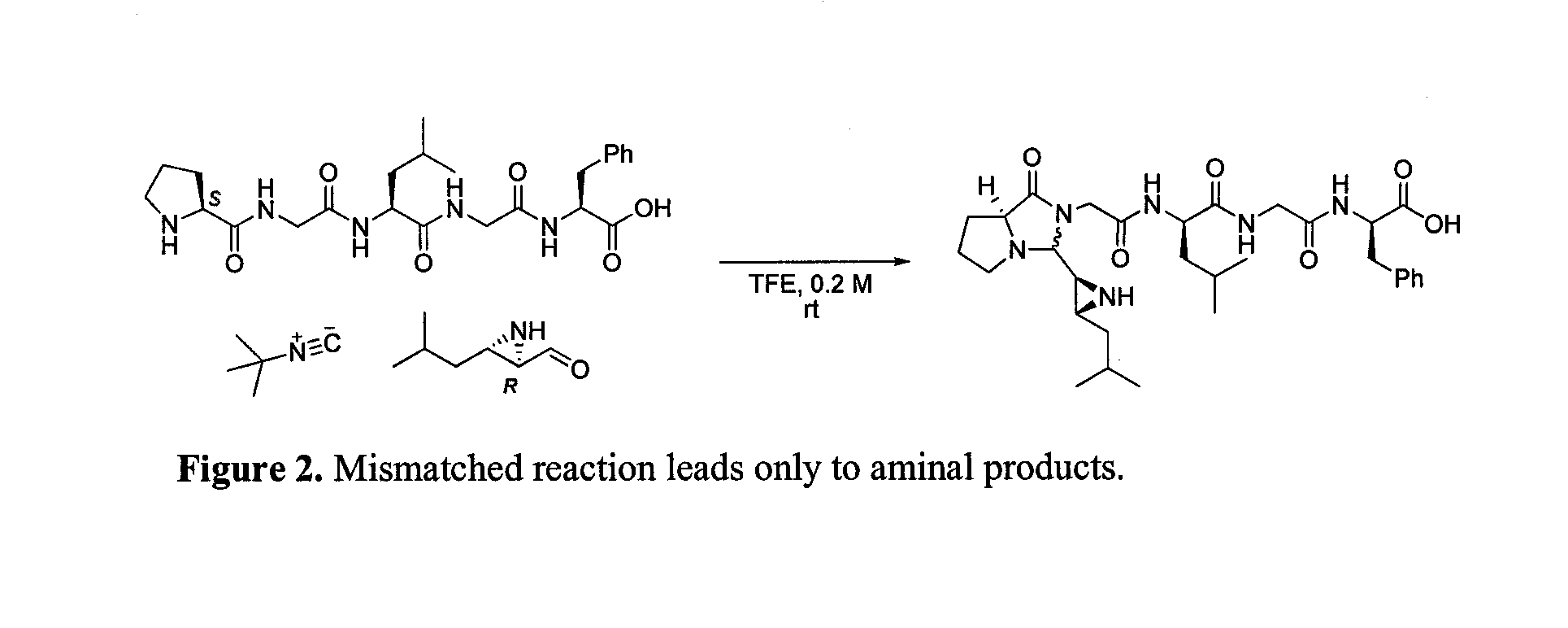Cyclic amino acid molecules and methods of preparing the same
a technology of cyclic amino acids and amino acids, which is applied in the field of cyclic amino acid molecules and methods of preparing the same, can solve the problems of poor in vivo stability of peptides, inability to form ion pairs, and difficult realization of the enormous therapeutic potential of peptides
- Summary
- Abstract
- Description
- Claims
- Application Information
AI Technical Summary
Benefits of technology
Problems solved by technology
Method used
Image
Examples
example 1
[0113]Materials and Methods
[0114]Anhydrous toluene and dimethylformamide (DMF) were purchased and used as received. Tetrahydrofuran (THF) was distilled from sodium benzophenone ketyl under argon. All other solvents including TFE (2,2,2,-trifluoroethanol) and HFIP (1,1,1,3,3,3-hexafluoro-2-isopropanol) were of reagent grade quality. Melting points were obtained on a MelTemp melting-point apparatus and are uncorrected.
[0115]Method 1: amino acid / peptide cyclization reaction was conducted using the following method. In a screw-cap vial equipped with a magnetic stirring bar was added peptide (0.2 mmol) and 1 ml of TFE and stirred until a homogeneous solution has been obtained. Aziridine aldehyde dimer (0.1 mmol) and isocyanide (0.2 mmol) were then added sequentially and the resulting mixture was stirred for the time specified in Table 1. Reactions were monitored by electrospray ionization mass spectrometry (“ESI-MS”) at 60 eV and / or thin layer chromatography (“TLC”) analysis. After compl...
example 2
[0182]Methods and Materials
[0183]Method A: ring-opening of aziridine-containing cyclic peptide is conducted using an aromatic thiol as the nucleophile (Method A). In a screw-cap vial equipped with a magnetic stirring bar was added aziridine-containing cyclic peptide (0.06 mmol) and aromatic thiol (0.066 mmol) were added to 0.2 ml of degassed CHCl3. NEt3 (0.06 mmol) was then added to the solution and the reaction was stirred at room temperature for 3-4 hours. The reaction was then diluted with CH2Cl2, and washed twice with saturated aqueous NH4Cl (3 ml) followed by one wash with brine (3 ml). The organic layer was subsequently dried over Na2SO4, filtered, and concentrated under reduced pressure. The crude ring-opened products were of high purity, but analytically pure samples were obtained following purification by flash column chromatography (5% MeOH in EtOAc).
[0184]Method B: ring-opening of aziridine-containing cyclic peptide is carried out using an aliphatic thiol or imide as the ...
example 3
[0191]X-ray analysis of cyclic product 1 was conducted.
[0192]Results
[0193]
[0194]
TABLE 4Crystal data and structure refinement for k07227.Identification codek07227Empirical formulaC24H38N3O3SiFormula weight445.67Temperature150(2) KWavelength0.71073 ÅCrystal systemMonoclinicSpace groupP 21Unit cell dimensionsa = 14.590(2) Åα = 90°.b = 12.326(2) Åβ = 94.718(7)°.c = 15.088(2) Åγ = 90°.Volume2704.2(7) Å3Z4Density (calculated)1.097 Mg / m3Absorption coefficient0.115 mm−1F(000)968Crystal size0.32 × 0.10 × 0.08 mm3Theta range for data collection2.62 to 23.05°.Index ranges−15 −15 Reflections collected10115Independent reflections3828 [R(int) = 0.1359]Completeness to theta = 23.05°95.9%Absorption correctionSemi-empirical from equivalentsMax. and min. transmission1.000 and 0.770Refinement methodFull-matrix least-squares on F2Data / restraints / parameters3828 / 1 / 559Goodness-of-fit on F21.044Final R indices [I > 2sigma(I)]R1 = 0.0982, wR2 = 0.2560R indices (all data)R1 = 0.1715, wR2 = 0.3055Largest diff...
PUM
| Property | Measurement | Unit |
|---|---|---|
| molar concentrations | aaaaa | aaaaa |
| length | aaaaa | aaaaa |
| concentration | aaaaa | aaaaa |
Abstract
Description
Claims
Application Information
 Login to View More
Login to View More - R&D
- Intellectual Property
- Life Sciences
- Materials
- Tech Scout
- Unparalleled Data Quality
- Higher Quality Content
- 60% Fewer Hallucinations
Browse by: Latest US Patents, China's latest patents, Technical Efficacy Thesaurus, Application Domain, Technology Topic, Popular Technical Reports.
© 2025 PatSnap. All rights reserved.Legal|Privacy policy|Modern Slavery Act Transparency Statement|Sitemap|About US| Contact US: help@patsnap.com



